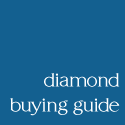Diamond Shapes
The classic diamond is, to most people, a round gem of sparkling white brilliance with a kaleidoscope of dazzling facets to entice the eye.
Yes and no. The traditional round brilliant diamond, though the most popular diamond shape of all, is hardly the whole story.
By the diamond cutter’s art these diamonds are carved into gems of spectacular and whimsical beauty. A cutter’s skill will produce a diamond of the greatest size with the fewest flaws and the most brilliance.
 Asscher Cut Diamond
Asscher Cut Diamond
The “Asscher cut diamond” was developed in 1902 by the Asscher Brothers of Holland. It is a stepped square cut, often called the “square emerald cut” and like an emerald cut, the Asscher has cropped corners.
- Learn more about the Asscher Cut Diamond
 Cushion Cut Diamond
Cushion Cut Diamond
An antique style of cut that looks like a cross between an Old Mine Cut (a deep cut with large facets that was common in the late 19th and the early 20th centuries) and a modern oval cut.
- Learn more about the Cushion Cut Diamond
 Emerald Cut Diamond
Emerald Cut Diamond
This is a rectangular shape with cut corners. It is known as a step cut because its concentric broad, flat planes resemble stair steps. Since inclusions and inferior color are more pronounced in this particular cut, take pains to select a stone of superior clarity and color.
- Learn more about the Emerald Cut Diamond
 Heart Shaped Diamonds
Heart Shaped Diamonds
This ultimate symbol of romance is essentially a pear-shaped diamond with a cleft at the top. The skill of the cutter determines the beauty of the cut. Look for a stone with an even shape and a well-defined outline.
- Learn more about the Heart Shaped Diamond
 Marquise Diamonds
Marquise Diamonds
An elongated shape with pointed ends inspired by the fetching smile of the Marquise de Pompadour and commissioned by the Sun King, France’s Louis XIV, who wanted a diamond to match it. It is gorgeous when used as a solitaire or when enhanced by smaller diamonds.
- Learn more about the Marquise Cut Diamonds
 Oval Diamonds
Oval Diamonds
An even, perfectly symmetrical design popular among women with small hands or short fingers. Its elongated shape gives a flattering illusion of length to the hand.
- Learn more about Oval Diamonds
 Pear Shaped Diamonds
Pear Shaped Diamonds
A hybrid cut, combining the best of the oval and the marquise, it is shaped most like a sparkling teardrop. It also belongs to that category of diamond whose design most complements a hand with small or average-length fingers. It is particularly beautiful for pendants or earrings.
- Learn more about Pear Shaped Diamonds
 Princess Cut Diamond
Princess Cut Diamond
This is a square or rectangular cut with numerous sparkling facets. It is a relatively new cut and often finds its way into solitaire engagement rings. Flattering to a hand with long fingers, it is often embellished with triangular stones at its sides. Because of its design, this cut requires more weight to be directed toward the diamond’s depth in order to maximize brilliance. Depth percentages of 70% to 78% are not uncommon.
- Learn more about the Princess Cut Diamond
 Radiant Cut Diamonds
Radiant Cut Diamonds
This square or rectangular cut combines the elegance of the emerald shape diamond with the brilliance of the round, and its 70 facets maximize the effect of its color refraction. Because of its design, this cut requires more weight to be directed toward the diamond’s depth in order to maximize brilliance. Depth percentages of 70% to 78% are not uncommon.
- Learn more about the Radiant Cut Diamond
 Round Brilliant Diamonds
Round Brilliant Diamonds
This shape has set the standard for all other diamond shapes, and accounts for more than 75% of diamonds sold today. Its 58-facet cut, divided among its crown (top), girdle (widest part) and pavilion (base), is calibrated through a precise formula to achieve the maximum in fire and brilliance.
- Learn more about Round Brilliant Diamonds
 Trilliant Diamonds
Trilliant Diamonds
This is a spectacular wedge of brittle fire. First developed in Amsterdam, the exact design can vary depending on a particular diamond’s natural characteristics and the cutter’s personal preferences. It may be a traditional triangular shape with pointed corners or a more rounded triangular shape with 25 facets on the crown, 19 facets on the pavilion, and a polished girdle. It is definitely for the adventurous.
The trilliant diamond is not readibly available as a solitaire and in contemporary jewelry is most often used for accent stones.
Diamond Education
4Cs of Diamond Grading | Diamond Cut | Diamond Clarity | Diamond Color | Carat Weight | Diamond Certificates | Diamond Size Chart | Diamond Fluorescence | Diamond Ring Settings | Diamond Glossary
Diamond Shapes
General Shapes Information | Asscher Cut Diamonds | Cushion Cut Diamonds | Emerald Cut Diamonds | Heart Shaped Diamonds | Marquise Cut Diamonds | Oval Diamonds | Pear Shaped Diamonds | Princess Cut Diamonds | Radiant Cut Diamonds | Round Brilliant Diamonds


 Tweet
Tweet